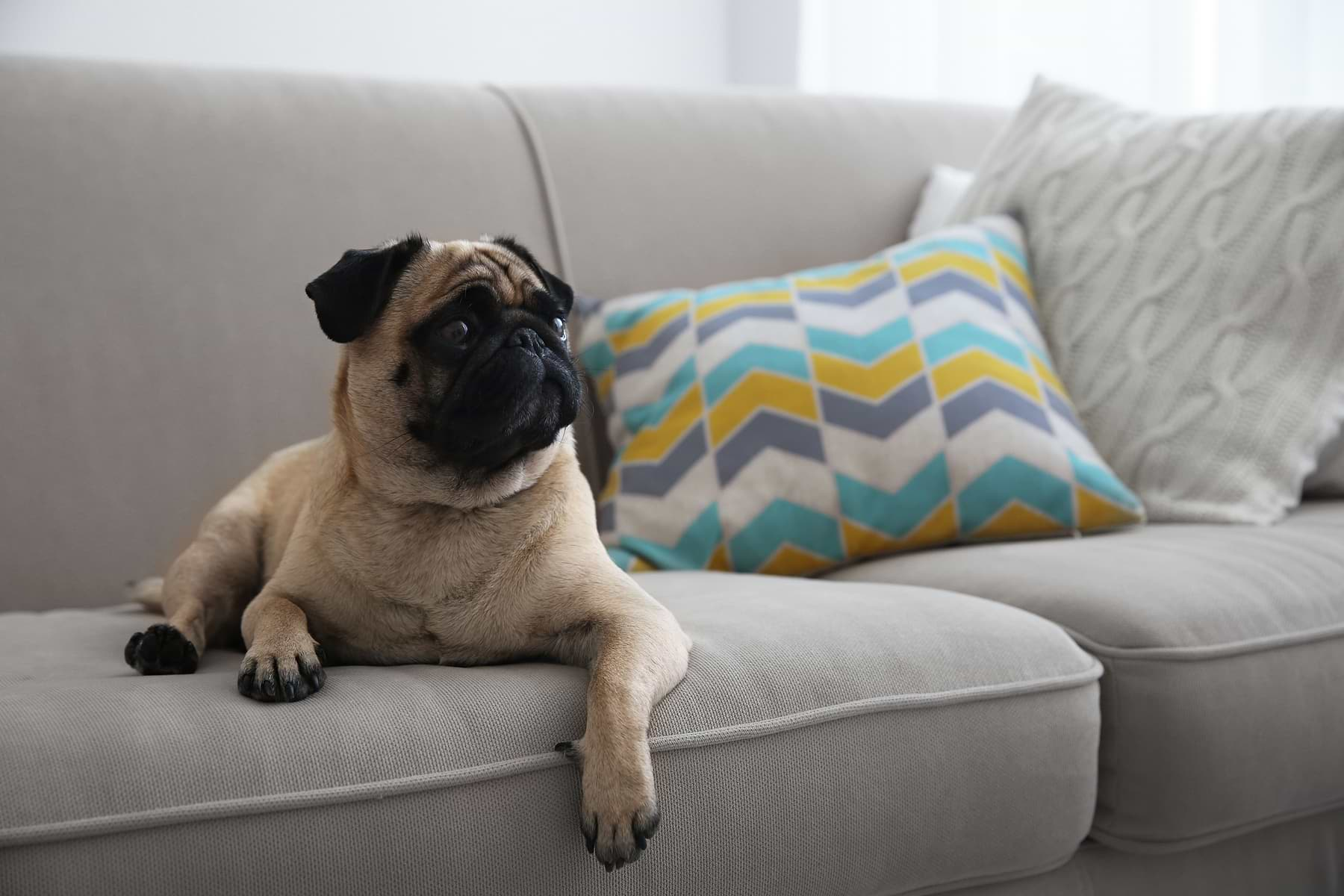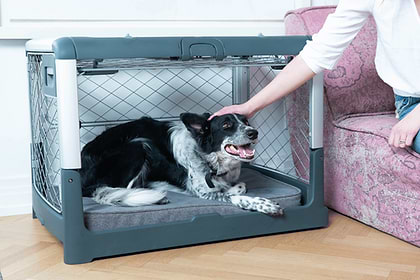Keeping your pup in check is an important part of being a pet parent. In fact, rules and structure are good for your canine companion. Dogs tend to have their own instinctual behaviors, not all of which are appropriate for a home. House rules keep pets out of harm’s way and give them peace of mind.
There are a variety of house rules that you can put into action that will ultimately benefit your pet and enhance their life experience. Read on for a sample set of rules that will give your pet the down-low on what is and what is not acceptable.
Why Are Dog House Rules Necessary?
Humans aren’t the only ones that need structure in their day-to-day lives. Dogs benefit from structure too! Letting your pet do what they want in your home could be dangerous, destructive, and unhealthy. It’s important to establish boundaries and expectations from the get-go and stick to them. Your dog will appreciate the predictability, and you will benefit too.
How Should You Enforce Them?
All hands on deck for this part. Every single member of the household needs to be on the same page about what they’re enforcing upon their pet.
When all are in agreement, the boundaries and limitations should be consistent, as that will make it easier for your canine companion. After all, your pet is just another member of the family, and we want them to feel safe and secure in your space.
The keyword is your, as we want your pet to be aware that this is your space they’re living in. Narrow it down. What is the most important thing for you and your family members? Does your partner care if your dog sleeps on the bed? On the couch? Are they allowed to be in your bedroom at all? Create a list of things that matter to the household the most, and go from there.
All of the tips and tricks below utilize positive reinforcement and never punishment. Check them out!
Examples of Dog House Rules
Your own personal set of rules don’t have to exactly match the one below. Your rules should coincide with your lifestyle and daily routine. Make a plan that works for you. But once you’ve established your set of rules, it’s important to enforce them consistently and clearly and have patience for your pup.
1. The Furniture
People have different takes on furniture privileges. Some pet parents don’t mind if their pup snoozes on the couch next to them. Others don’t like the fact that having their dog on the couch will eventually make it dirty and smelly.
Keep in mind that having a tiny little puppy versus a full-grown adult dog on your couch is very different. That is why it’s important to establish these rules from the start and to stick with them throughout their lifetime.
You can regulate furniture rules in a number of ways. Maybe you only let your pup on certain pieces of furniture and not others. No to the couch, but yes to the armchair (or vice versa). Or maybe your dog is only allowed on the couch when they are invited up but are not allowed to take it upon themselves to jump up.
You can associate specific verbal cues for furniture time so your pet knows when it is acceptable and when it is not. Whatever the case, set the rule from the start and again, keep it consistent.
2. Guests in Your Home
It is important that your dog understands how to greet guests or people that enter your home. Jumping up on guests is a very typical dog behavior that could become dangerous for small children or the elderly. There is potential for serious injury.
Be wary of how your dog acts when people enter your house. And remember, a fuzzy little puppy jumping on the big legs of a human is very different than a full-grown adult dog exhibiting the same behavior. While it’s tempting to want your puppy to jump up to your knees, this could become a real problem down the line.
This doesn’t mean that dogs can never jump. It’s possible to teach your dogs to greet guests politely (no jumping up) while also teaching them a jump cue, making sure they get positively reinforced for jumping up only if they are asked to do so. Similar to the furniture situation, you are setting boundaries and limitations for your canine companion and teaching them what is acceptable behavior and what is not.
It might be beneficial for you to teach your dog to stay quiet when a guest walks through your door as well. Barking can cause alarm or distraction. Excessive barking can lead to out-of-control behavior. It’s normal for your dog to bark when the doorbell rings, but they should be able to be quiet on command.
3. Scraps From the Table
Begging. It’s always better to start your dog out on the great path of no begging at the table. It’s difficult to resist the puppy eyes beneath you that just want a little bite of your pizza crust, which is why it’s better to nip this in the bud from the start. Feeding your dog from the table reinforces unwanted behavior, and unfortunately, human scraps time and time again can lead to stomach issues and obesity.
You can discourage begging by feeding your dog first and in a separate room than your kitchen or dining room. They’ll be so worried about their next bite of kibble that they won’t have time to bother you. You can also teach them alternative behaviors, like sending your pup to a snug spot while you eat, which could be their bed or their crate.
Again, these rules are mere suggestions and as the pet parent, you should make informed decisions that are best suited for you, your dog, and your lifestyle.
4. Crate Training
Crate training is a great way to acclimate your pet to the home. Your dog should understand that their crate is a happy place to be, and it’ll also keep them from getting into trouble when you’re not around.
Set your pup up for success by investing in a crate that’s durable, made from premium materials, and is easy to transport. Incorporate a crate pad so their little home is extra snug. Train them to love their crate by utilizing a proper crate training tool that will light up your dog’s world.
Using a crate is a great way to house train your pet. The confinement encourages control and helps establish boundaries. They are especially helpful in the first few weeks of a dog’s life.
5. Dog Placement
Where is your dog allowed to go while in the house? Where are they not allowed to go? Creating firm boundaries and limitations in your household is healthy for your pet, not restricting.
For instance, the kitchen tends to be a problem area as dogs are tempted to jump on the counters, lick the dishes when the dishwasher is open, and rummage through the garbage. Establishing a “no kitchen” rule is not a bad thing.
The same goes for the bedroom. If you don’t want your dogs jumping on the bed or snagging your child’s toy, keep them out of the bedrooms. Banning your pet from certain rooms provides a basic sense of leadership and allows you to have some peace of mind.
And then, of course, the bathrooms. Keep your dog from getting close to the toilets, as we don’t want them drinking from that water. Train your pup that certain rooms are okay and certain rooms are not and your mind isn’t going to change on that. If you give your dog an inch, they’ll take a mile. Keep that in mind as you set these rules.
6. Chewing
If your dog gets into the bad habit of chewing things they should not, it won’t be fun for anyone involved. Dogs' tendency to chew is innate, so it’s better to train them properly from the start. As a matter of fact, the majority of puppies go through a destructive chewing phase at the beginning of their lives. Shoes, socks, furniture, and couch pillows are a no. Squeaky toys, plush animals, and bones are a yes.
You don’t need to stop the chewing, you just need to manage it. Uninterrupted repetition leads to habits and patterns which leads to set behaviors. If you see your pup chewing on something they shouldn't, immediately take it away and provide them with a safe-for-dog chew.
Did you know that when puppies are teething and they bite down on something, “feel-good” chemicals are released and the pain subsides? Knowing that, supply your puppy with the right chew toys and they will stay away from the furniture.
7. The Whole Household
We’ve already mentioned that it’s vital for the entire household to be on board if you’re wanting to properly teach your dog the house rules, but let’s discuss again. Take the time to sit down with everyone in your house and decide what the set of rules is going to be.
It can become very confusing for your pet if one person is enforcing a “no couch” rule while another is allowing them to hop up and snuggle. The same goes for food from the table. Remember that setting house rules is not about limiting your canine companion, but giving them healthy boundaries.
8. Routine
Incorporating structure into your dog’s life is a good way to manage them. A smooth-flowing daily routine is a great way to set limitations and provide a safe space for your pup. Keeping this routine consistent is important, with the understanding that adjustments will be necessary as life happens. Solidify a schedule that works for both your pet and your household.
Note that you want to teach your dog that being flexible is important. While having a routine is ideal, strict adherence to a routine could create anxiety in pups. We don’t want your dog getting thrown out of whack if you’re having a day that causes you to stray from your normal routine. Unplanned events happen, and your dog needs to be flexible.
9. Snooze Rules
Begin with answering these questions. Where is your dog allowed to sleep? Where are they not allowed to sleep? Will they be crated while their pet parents are sleeping? Maybe you don’t crate your dog and they sleep through the night on their comfy bed in the hallway.
Crating your dog at night is a good way to housebreak your pet. Consider keeping your dog in their crate throughout the night. Not only will they feel snug inside their little safe haven, but they won’t get into any trouble if they happen to wake up in the middle of the night.
10. Bathroom Breaks
There are a couple of ways to go about bathroom breaks. Each household is different. Do what works best for you. Some people live in the city in a building with no backyard space. Other people live in a more suburban setting, where a grassy area is easily accessible. This will have an effect on how you train your dog to relieve themselves.
If you’re living in a home with accessible outdoor space, train your dog to only go outside. Start by assessing how often your dog needs to go to the bathroom. In other words, how long can your dog hold it? What is their bladder like? Keep a consistent “going out schedule.” Make sure you are positively reinforcing your pup each time they relieve themselves in their proper, outdoor space.
If you are living in a home with no easy outdoor access, you’ll have to figure out another way to potty train your pup. Perhaps you can prepare a designated place for your pet to relieve themselves indoors. This could be a potty pad or another type of dog litter box. While some of them use artificial grass, there are pup litter boxes that use real grass. This is a great option for your city canine.
Additional Tips and Tricks for Pet Parents
Bringing a dog into your home, whether a puppy or fully grown, is no easy feat. While the love you have for your dog will likely prevail over anything else, there will be many challenges along the way and there will be times that you feel overwhelmed. While it is great to establish a healthy set of house rules for your dog, it’s important to give yourself some rules as well. Pet parents need teaching too.
Do Not Use Physical Punishment
Your dog is bound to break some house rules. Do not use physical punishment on your pet. You want to establish trust between you and your animal. Getting physical will make your dog more fearful than anything else and will likely contribute to problematic behavior. Use positive reinforcement to teach your dog right from wrong.
Learn Your Own Boundaries
When a dog is eating, leave them be. When a dog is sleeping, leave them be. In the same way that you want your pup to respect your boundaries, you need to respect your pup’s boundaries just the same. Disturbing a dog unwarranted can lead to anxiety and aggression.
Have Some Understanding
While your dog is learning house rules, have some empathy and understanding. If you know that your socks are going to cause chewing temptation, keep them out of reach. If you know that your dog is going to snag your shoes and bring them to the crate, put your shoes in the closet. Don’t make the process harder for your pet.
Summary
You made it to the end! Way to go. To conclude, there are a handful of house rules that you can implement for your dog in order to better manage them. You’ll want to set these boundaries and limitations from the start, as that will make it easier for your pet. Remember, dogs can learn at any stage of life, so don’t be discouraged for a senior dog. Have faith in them.
Decide on whether you want your dog to have access to the couch or your bed. Take into account your dog’s age and whether it will be just as cute for your seven-year-old canine to crash on the couch as it is when they are seven months.
Figure out how you want your pet to greet guests, and whether it’s okay for them to jump and bark. Are you ok with them begging? Or do you prefer that they keep to their own personal space when your dinner is served?
In addition, crate training is a great way to set boundaries. So is prepping them with a daily routine (with the caveat that your dog is able to stay flexible for when things change last minute).
Teach your dog what’s acceptable to chew and what’s not, and have all of your family members on board to mitigate confusion. Informing your dog where to snooze and where not to snooze and creating a potty break schedule for them are both good ways to manage your pet.
Don’t forget to educate yourself on why house rules are necessary and make sure you’re putting in the work. What are you looking to achieve? How are you going to enforce these rules? House rules keep pets out of harm’s way and give them peace of mind. Same with the pet parent! Knowing your dog has its own set of boundaries will give you an equal amount of calm.
Sources:
How to Create House Rules for Your New Puppy | American Kennel Club
Dog House Rules | Whole Dog Journal
Stop Your Dog From Jumping Up | Humane Society
How to Stop a Dog From Begging | American Kennel Club
Dog Training — Set House Rules Template | Preventative Vet
Potty Training a Puppy: How to House Train Puppies | American Kennel Club

The Diggs Team
We believe our dogs deserve safer, better designed pet products.
You might also like
Crate training tips, stories and inspiration
View all blogsIn Your Diggs
Share your photos with #DiggsPet and tag us @DiggsPet on IG and TikTok.



